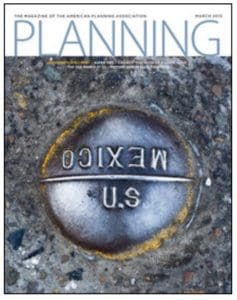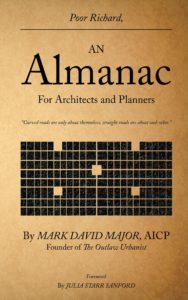We came across this disturbing photograph taken at the 1972 American Planning Association Future Leaders Conference:
From left to right (standing):
John de Lancie gave up planning and became an actor, getting his start playing several roles on The Six Million Dollar Man before most famously playing “Q”, a being with God-like powers, in Star Trek: The Next Generation.  When asked how he approached playing an omnipotent being, he replied, “I based Q’s pretentiousness on one of my planning professors at Kent State University.”
When asked how he approached playing an omnipotent being, he replied, “I based Q’s pretentiousness on one of my planning professors at Kent State University.”
Steven Littleton, PA became a real estate attorney and broker as well as part-time magician in Las Vegas, Nevada. He still performs weekly at the Leopard Lounge and Style Revue in North Las Vegas under the pseudonym “The Magnificent Steven.”
William Bonin was convicted and executed in 1996 as the “Freeway Killer” in Los Angeles, California.
Gregory Marmalard, FAICP became the Special Assistant for Community & Development to Governor Kathleen Babineaux Blanco of Louisiana. He advised Governor Blanco that Lousiana did not need Federal assistance in the aftermath of Hurricane Katrina in 2005. He is currently serving as a Assistant Deputy Secretary for the Department of Transportation in Washington, D.C.
Douglas C. Neidermeyer, AICP was killed by his own planning staff in Little Vietnam in the Uptown area of the City of Chicago. The planning staff was acquitted of the murder on the grounds of “temporary sanity.” It is still the only case in history of the United States judiciary that was ever decided on these grounds.
Dr. Ronnie F. Farley, FAICP received his PhD from the University of Santa Barbara, Remote Learning Campus and became APA President in the late 1980s. He was convicted of money laundering for misuse of Federal housing funds in the mid-1990s and sentenced to 20 years in prison. He was released for good behavior in 2002 from the Federal Prison Camp, Alderson in West Virginia. He became a best-selling author, publishing under the pseudonym “Stephanie Meyer.”
Seventh person standing to the far left remains unidentified though several eye witnesses have sworn his name is Abad’on Beel z’bub, an exchange student from Hierapolis in southwest Turkey.
Center, being spanked:
 Chip Diller, AICP has been the serving Planner II of Bacon County, Georgia since 1982 where he won 10 awards for meritorious long service before the County Commissioners discontinued the award. He is a avid fan of the 1980s game, Dungeon and Dragons, and a three-time winner of the P&D Championship Series.
Chip Diller, AICP has been the serving Planner II of Bacon County, Georgia since 1982 where he won 10 awards for meritorious long service before the County Commissioners discontinued the award. He is a avid fan of the 1980s game, Dungeon and Dragons, and a three-time winner of the P&D Championship Series.
Kneeling, left to right:
W.F. Scott never finished planning school at the University of Minnesota. He became a factory worker and the father of Seann William Scott, who co-starred in several American Pie films and The Dukes of Hazard remake in 2005.
William Patrick went missing in 1978. He was officially declared dead by his family in 1985.
Thurston Howell V served as the National Director of the Sierra Club from 1985-1992. Officially, he is “retired” though, according to anonymous sources, this really means he was committed to the Elizabeth Arkham Asylum in 2002 and screams “rising ocean levels” every hour on the hour, night or day.




 Planning Naked | March 2015
Planning Naked | March 2015


 “Poor Richard” Review | Planning Magazine
“Poor Richard” Review | Planning Magazine

 When asked how he approached playing an omnipotent being, he replied, “I based Q’s pretentiousness on one of my planning professors at Kent State University.”
When asked how he approached playing an omnipotent being, he replied, “I based Q’s pretentiousness on one of my planning professors at Kent State University.” Chip Diller, AICP has been the serving Planner II of Bacon County, Georgia since 1982 where he won 10 awards for meritorious long service before the County Commissioners discontinued the award. He is a avid fan of the 1980s game, Dungeon and Dragons, and a three-time winner of the P&D Championship Series.
Chip Diller, AICP has been the serving Planner II of Bacon County, Georgia since 1982 where he won 10 awards for meritorious long service before the County Commissioners discontinued the award. He is a avid fan of the 1980s game, Dungeon and Dragons, and a three-time winner of the P&D Championship Series.